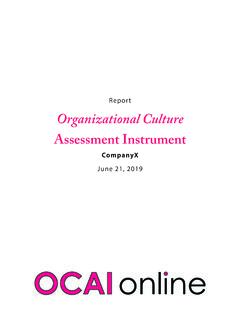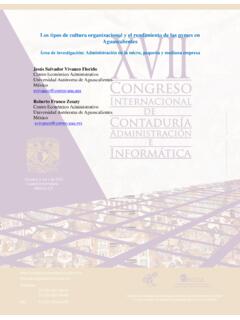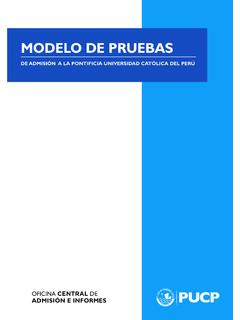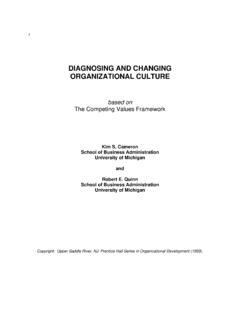Transcription of The Competing Values Culture Assessment
1 Kim S. cameron and University of Michigan Regents The Competing Values Culture AssessmentA Tool from the Competing Values Product Line Kim S. cameron Robert E. Quinn The OCAI -- Organizational Culture Assessment Instrument Diagnosing and Changing Organizational Culture : Based on the Competing Values Framework, 3rd Edition Kim S. cameron , Robert E. Quinn ISBN: 978-0-470-65026-4 Paperback 288 pages March 2011 From: Kim S. cameron and University of Michigan Regents An Introduction to the Competing Values Framework The Competing Values Framework (CVF) has been recognized as one of the forty most important models in the history of business. It originally emerged from empirical research on what factors make organizations effective. The framework has since been applied to a variety of topics related to individual and organizational behavior. It has been the focus of empirical studies for more than 25 years, and it has been employed to help thousands of organizations and tens of thousands of managers improve their performance.
2 References to a number of books and scholarly publications testing and validating the framework are available from the authors. THE Competing Values FRAMEWORK Kim S. cameron and University of Michigan Regents The Four Quadrants The Competing Values Framework (CVF) consists of two dimensions one drawn vertically and the other drawn horizontally resulting in four quadrants. When studying the effectiveness of organizations more than two decades ago, it was discovered that some organizations were effective if they demonstrated flexibility and adaptability, but other organizations were effective if they demonstrated stability and control. Similarly, some organizations were effective if they maintained efficient internal processes whereas others were effective if they maintained competitive external positioning relative to customers and clients. These differences represent the different ends of two dimensions, and these dimensions constitute the rudiments of the Competing Values Framework.
3 Each quadrant in the framework represents a way of being, seeing, managing, and organizing. The Collaborate Quadrant The Collaborate quadrant represents the kinds of people, purposes, and processes that give rise to cooperation and collaboration. People in the Collaborate quadrant tend to be committed to their community, focusing on shared Values and communication. Their Culture is oriented towards involvement and building commitment over time. Companies dominated by this Collaborate quadrant often seek to be the employer of choice. Driving purposes include cohesion and commitment. Leaders build the organization by encouraging trusting relationships and by nurturing a sense of community. Unified behavior produces a strong organizational image in the marketplace. Customers may be considered partners in an extended community. The Collaborate quadrant taken to an extreme becomes negative and turns into a permissive, lax environment where outcomes and results are under-emphasized.
4 The Create Quadrant The Create quadrant represents the kinds of people, purposes, and practices that are associated with creativity, innovation, and vision. Individuals with this perspective tend to be change oriented. The Culture that supports their work is characterized by experimentation, flexibility, and looking forward toward the future. The focus is on generating new ideas. These organizations tend to emphasize and support entrepreneurial activities. Companies in this Create quadrant tend to seek to value things that are new. Driving purposes include innovation and growth. They orient their products, services, and ideas toward the future. Managers build the organization by developing a compelling vision and emphasizing new ideas and technologies, flexibility, and adaptability. These organizations can thrive in turbulent environments. The Create quadrant taken to an extreme becomes negative by being constantly chaotic, trying out multiple new ideas, and under-emphasizing the achievement of predictable outcomes and structure.
5 The Compete Quadrant The Compete quadrant represents the kinds of people, purposes, and practices that are associated with aggressive competition and achievement. A focus on achieving results leads people to emphasize winners or losers. Individuals with this perspective tend to be focused on performance and goal achievement. Companies that emphasize this Compete quadrant tend to emphasize speed and getting results. Driving purposes include profits, obtaining market share, revenues, brand equity, and speed of response. Managers build the organization by clarifying objectives and improving the firm s competitive position through hard work, competitive strategy, and productivity. These organizations seek to deliver results to stakeholders as quickly as possible. Beating the Kim S. cameron and University of Michigan Regents competition is central. The Compete profile taken to an extreme becomes negative by giving rise to self-interests and conflict and by neglecting the more humane people issues.
6 The Control Quadrant The Control quadrant represents the kinds of people, purposes, and practices that give rise to predicable, dependable performance. People in organizations dominated by the Control quadrant tend to be systematic, careful, and practical. The Culture emphasizes planning, efficient systems and processes, and enforcing compliance. Companies that emphasize the Control quadrant tend to keep things running smoothly and efficiently. Driving purposes include obtaining high quality or optimization, sometimes expressed as predictability or minimizing variation and errors. Managers build the organization by optimizing processes, cutting costs, and establishing policies and procedures. Clear role definitions are important. These organizations tend to elaborate or extend existing products and services with minor variations. The Control quadrant taken to an extreme becomes negative by leading to red tape, languishing bureaucracy, and organizational stagnation.
7 An advantage of the Competing Values Framework is that it is based on a well-developed theoretical and empirical foundation. A great deal of research has been produced to validate the CVF and its applications. It is consistent, for example, with the psychology of Jung, the sociology of Parsons, the philosophy of Wilber, and the brain physiology of Lawrence. Individuals taking the assessments, as well as organizations receiving data on their own attributes, can link their results to other well-developed elements of improvement. Most importantly, the empirical research conducted by scholars in hundreds of organizations, coupled with the hundreds of interventions in real organizations that have utilized the Competing Values Framework, provide a rich array of guidelines and prescriptions for how to improve individual and organizational performance. These are not merely conveniently created instruments. They are, rather, an integrated array of Assessment devices aimed to help enable and enhance consistent and comprehensive improvement.
8 Kim S. cameron and University of Michigan Regents THE Competing Values Culture Assessment Why should I use the Competing Values Culture Assessment ? The purpose of this Assessment is to diagnose your organization s current and desired Culture . Unfortunately, most of us are not even aware of our organization s Culture inasmuch as Culture represents just the way things are around here. Culture is the sum of the collective assumptions, expectations, and Values that reflect explicit and implicit rules in the organization. Until challenged or violated, most people are not even aware that these assumptions and rules exist (such as speaking English or being polite). As a result, it is very difficult to intelligently discuss Culture , not to mention try to change it. We learn about the Culture of our organization through socialization processes, interactions under uncertain conditions when we mostly rely on core habits and the most well-learned responses and by contagion (or unconscious mimicking).
9 Much of that learning, however, is not systematic or conscious. Understanding organizational Culture is important because it is the single largest factor that inhibits organizational improvement and change. Research is clear that healthy cultures enhance success whereas unhealthy cultures inhibit success, but in order to take advantage of the power of organizational Culture , it must be adequately measured. Research by cameron and Mora found that 96 percent of the time successful mergers and acquisitions could be accurately predicted based solely on cultural match. Organizational change and improvement, in other words, is markedly affected by Culture . A change in organizational Culture can occur simply by means of life cycle development , evolutionary changes or as a result of a major threat or crisis when dramatic transformations occur. The most productive way to facilitate Culture change, however, is through competent leadership and systematic change initiatives.
10 This instrument helps identify the cultural profile of your organization which is a prerequisite for fostering organizational change and improvement. Because the instrument is based on the Competing Values Framework, it can help create a common language among employees within your organization and give them an easy way to discuss how to effectively achieve desired results. Kim S. cameron and University of Michigan Regents The Competing Values Culture Assessment These six questions ask you to identify the way you experience your organization right now, and, separately, the way you think it should be in the future if it is to achieve its highest aspirations. In the survey, the organization refers to the organization managed by your boss (or the organization in which you manage). Please rate each of the statements by dividing 100 points between alternatives A, B, C, and D depending on how similar the description is to your firm.





